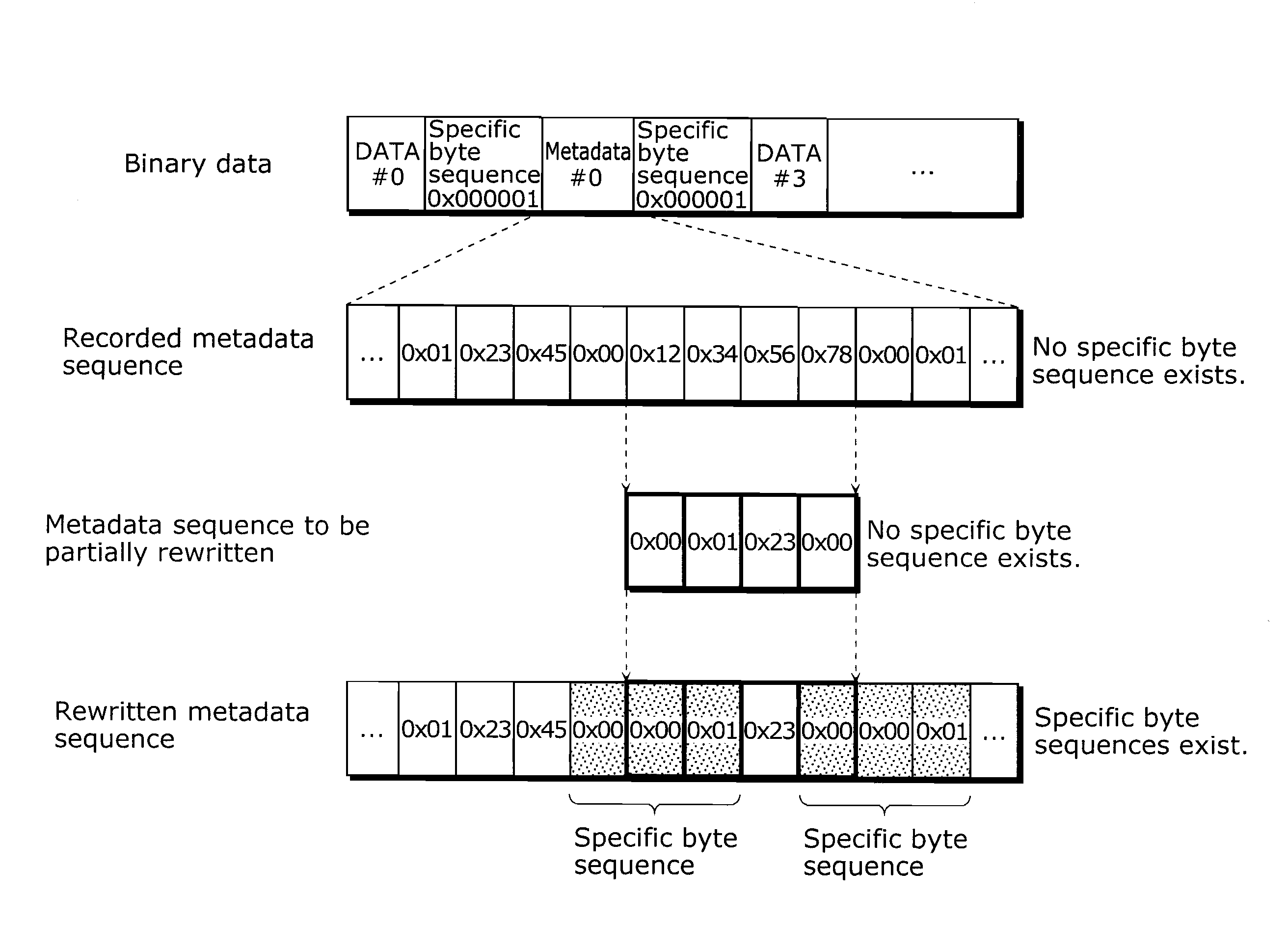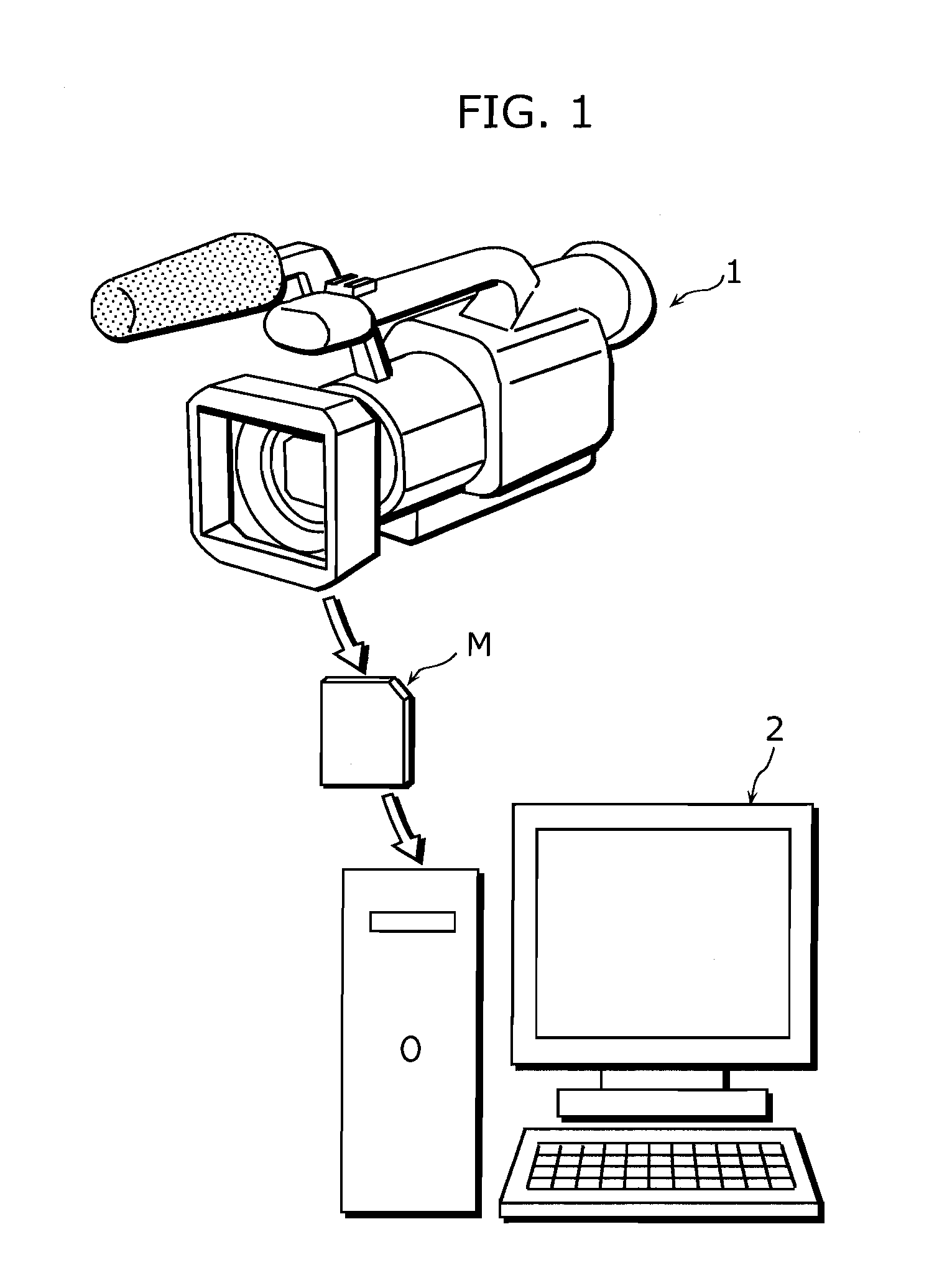Metadata recording device and method thereof
a recording device and metadata technology, applied in the field of metadata recording devices, can solve the problems of reducing the degree of metadata freedom, unable to distinguish a boundary between video data, and unable to use prohibited data as the identifier for data segments,
- Summary
- Abstract
- Description
- Claims
- Application Information
AI Technical Summary
Benefits of technology
Problems solved by technology
Method used
Image
Examples
embodiment 1
[0052](Embodiment 1)
[0053]FIG. 1 is a diagram illustrating a situation in which the present invention is put to practical use.
[0054]Here, a camera recorder 1 which records video signals and audio signals is exemplified. A recording memory M is removable from the camera recorder 1. The camera recorder 1 can record in file the video signals and the like in the recording memory M. An editing device 2 such as a personal computer can edit the files generated by the camera recorder 1 via the recording memory M.
[0055]The following will assume and describe a case in which supplemental enhancement information (SEI) in the H.264 standard is multiplexed with metadata. That is to say, binary data to be mentioned below is compressed data in compliance with the H.264 standard. Furthermore, a specific byte sequence is a byte sequence 0x000000, 0x000001, 0x000002, or 0x000003 that has three bytes and denotes a start code in the H.264 standard.
[0056]FIG. 2 is a diagram for illustrating a problem whe...
embodiment 2
[0070](Embodiment 2)
[0071]An aspect of the editing device 2, which is the example of the metadata recording device 10 according to the present invention, will be described in an embodiment 2.
[0072]FIG. 6 is a diagram illustrating a metadata editing method according to the embodiment 2.
[0073]As illustrated in the figure, the metadata editing method according to the embodiment 2 is characterized by editing metadata into which each of pieces of invalid data is inserted at intervals to change the metadata, so that the metadata does not include a specific byte sequence, the insertion causing the metadata to be data having a fixed length, the intervals being shorter than a length of the specific byte sequence indicating a segment of binary data. For instance, after all of the metadata sequences each of which is data having a fixed length (hereinafter, referred to as fixed-length metadata sequence) are read, pieces of invalid data included in the fixed-length metadata sequences are discard...
embodiment 3
[0081](Embodiment 3)
[0082]Another aspect of the editing device 2, which is the example of the metadata recording device 10 according to the present invention, will be described in an embodiment 3.
[0083]FIG. 9 is a diagram illustrating a metadata editing method according to the embodiment 3.
[0084]As illustrated in the figure, as with the embodiment 2, the metadata editing method according to the embodiment 3 is characterized by editing the metadata that is the data having the fixed-length. For example, after only a to-be-rewritten part of a metadata sequence to be edited among fixed-length metadata sequences is read and only the read part of the metadata sequence is edited, only the edited part of the metadata sequence is written into the to-be-rewritten part of the metadata sequence to be edited. In this manner, the metadata sequence is still the fixed-length data before and after the editing, and, no matter how many times the editing is performed, data located at corresponding posi...
PUM
 Login to View More
Login to View More Abstract
Description
Claims
Application Information
 Login to View More
Login to View More - R&D
- Intellectual Property
- Life Sciences
- Materials
- Tech Scout
- Unparalleled Data Quality
- Higher Quality Content
- 60% Fewer Hallucinations
Browse by: Latest US Patents, China's latest patents, Technical Efficacy Thesaurus, Application Domain, Technology Topic, Popular Technical Reports.
© 2025 PatSnap. All rights reserved.Legal|Privacy policy|Modern Slavery Act Transparency Statement|Sitemap|About US| Contact US: help@patsnap.com



